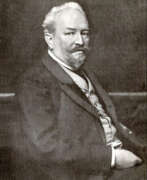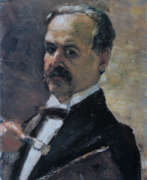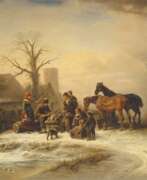Prussia


Stanisław Chlebowski was a Polish orientalist painter.
His travels in the Middle East and North Africa, where he lived and worked for many years, had a great influence on Chlebowski's work. His paintings often feature scenes of daily life in these regions, including depictions of markets, street scenes, and traditional clothing.
Today, Chlebowski's paintings can be found in many public and private collections, including the National Museum in Warsaw and the National Museum in Krakow.


Hermann Johann Ernst Gemmel was a German architect and artist of the mid-nineteenth century. He is known as an architectural painter and educator.
Hermann Gemmel studied painting at the Berlin Academy of Fine Arts and began to specialize in architectural painting, depicting mainly architectural sites in East Prussia and Italy. These paintings of his are of great historical value today. In 1855 he became professor of perspective and architecture at the Königsberg Academy of Arts.


August Kopisch was a German painter of the first half of the 19th century. He is known as a landscape painter and poet.
Kopisch began his path in art with painting, but switched to literature due to a hand injury. He studied at art academies in Dresden, Prague and Vienna. His paintings were characterized by bright colors. There are 23 known paintings by Kopisch, but some of them have not survived. One of his most notable masterpieces is the 1848 painting Pontic Moorlands at Sunset.
As a poet, Kopisch also left his mark on German literature and art. He notably translated Dante's Divine Comedy and Italian folk songs into German.


Paul Lehmann-Brauns was a German painter, known as a landscape painter.
Paul Lehmann-Brauns lived in Berlin, but found inspiration for his works in Hamburg, Potsdam, the Thuringian Forest and the Central German Uplands. The North Frisian Islands were his favourite subject.


Karl Friedrich Lessing was a German painter of the mid-nineteenth century. He is known as a Romantic painter, a representative of the Düsseldorf School of painting.
Lessing began his career with melancholic-romantic landscapes and paintings on literary subjects. He later gained popularity as a landscape painter. Reproductions of his works were widely printed in German magazines of the XIX century. Later Lessing switched to historical subjects, creating historical paintings, as well as frescoes.
Lessing was a member of various art societies and academies, both German and foreign.


Carl Ernst Morgenstern was a German landscape painter and professor at the School of Applied Arts in Breslau.
His father Christian E. B. Morgenstern was also a landscape painter and taught his son in his early years. Later Morgenstern studied with various teachers, including Josef Schertel, Eduard Schleich and Theodor Kotsch.
Carl Ernst Morgenstern was an important landscape painter of the 19th century. His style was influenced by the Barbizon School, which advocated painting en plein air and a realistic depiction of nature and landscape. Morgenstern also introduced these ideas into his teaching at the School of Arts and Crafts in Breslau and thus influenced an entire generation of artists. Today his works can be found in numerous museums and collections and he is considered one of the most important landscape painters of his time.


Otto Mueller was a German artist of the first third of the twentieth century. He is known as a painter, graphic artist and printmaker, a representative of German Expressionism, a member of the artists' group "Bridge".
Otto Mueller is considered one of the most lyrical German expressionist painters. His work reflected the unity of man and nature, characterized by simplification of forms, colors and contours. He became famous for his paintings of nude bodies and gypsy women, because of his fascination with which the artist was once nicknamed "Gypsy Mueller".
Mueller preferred to work in tempera on rough canvas, creating a matte surface. His artistic legacy includes 172 works, including lithographs, woodcuts and etchings.


Richard Riemerschmid was a German architect, painter, designer and city planner from Munich. He was a major figure in Jugendstil, the German form of Art Nouveau, and a founder of architecture in the style. A founder member of both the Vereinigte Werkstätte für Kunst im Handwerk (United Workshops for Art in Handcrafts) and the Deutscher Werkbund and the director of art and design institutions in Munich and Cologne, he prized craftsmanship but also pioneered machine production of artistically designed objects.


Hermann Schmiechen was a German painter of the late nineteenth and first quarter of the twentieth centuries. He is known as a painter, graphic artist, portraitist, representative of the Düsseldorf School of painting, and theosophist.
Hermann Schmiechen studied art in Breslau and Düsseldorf, and was a member of the art association "Malkasten". In 1883 he was invited to England to create portraits of the British aristocracy. In London, the artist became a member of the Theosophical Society. At the request of Helena Blavatsky, the head of the society, he drew several portraits of theosophical mahatmas. According to researchers, the master showed certain psychic abilities, which makes his work interesting and unique.


Lesser Ury was a German painter of the late nineteenth and first third of the twentieth centuries of Jewish origin. He is known as an impressionist painter, graphic artist and printmaker, a representative of the Düsseldorf school of painting.
Ury painted rural and urban landscapes, still lifes and monumental paintings on biblical themes. His works depicting the streets of Berlin and views of Brandenburg are particularly notable. Ury mastered both oil colors, creating floral paintings and urban scenes, and pastels, conveying an atmosphere of air and light in landscapes.


Michael Leopold Lukas Willmann was a German painter of the second half of the 17th and early 18th centuries. He is considered the outstanding painter of Silesia of the Baroque period, and has been called the "Silesian Rembrandt" or "Silesian Raphael".
Willmann became known for his technical mastery as well as the speed with which he executed commissions. During his lifetime he created about 500 paintings and frescoes, of which about 300 have survived to this day. He used a special technique of painting the background and correcting details, which was also used by his pupils. Biblical subjects were at the center of Willmann's work, and his frescoes adorn churches and monasteries in Silesia to this day.

















